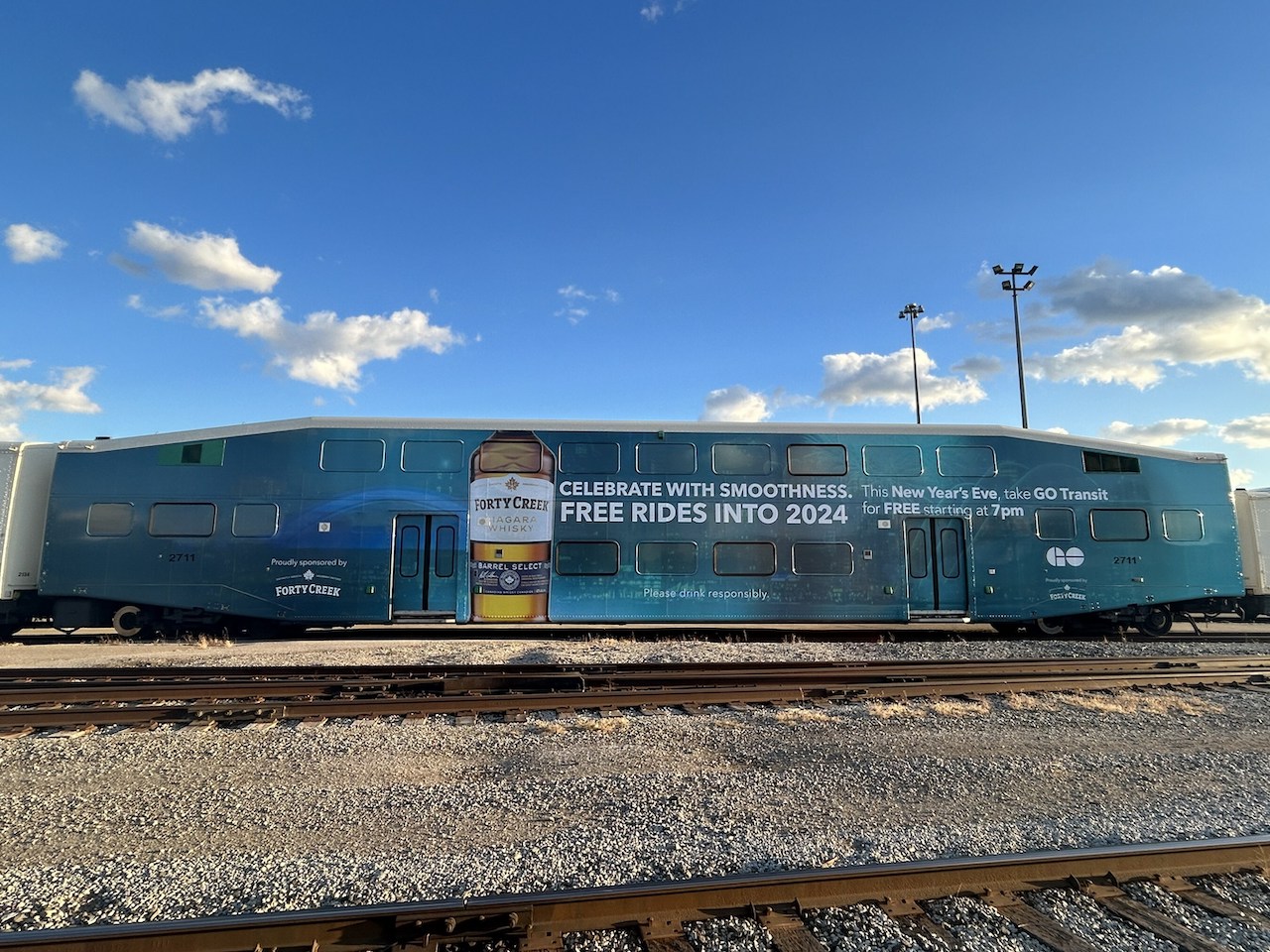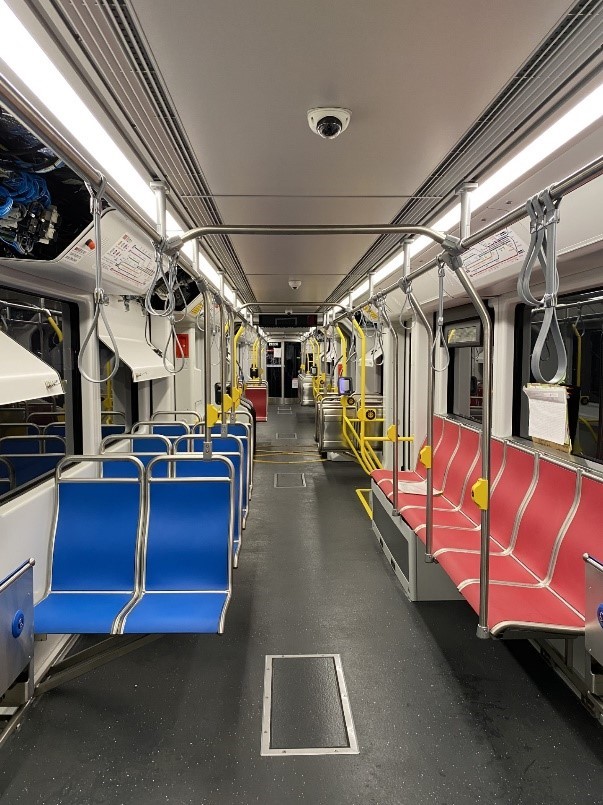
Transit Briefs: Metrolinx, NJ Transit, FTA, CTA, SFMTA, TTC
Written by Carolina Worrell, Senior Editor
Forty Creek® Canadian Whisky and Metrolinx will provide free rides on GO Transit and UP Express on New Year's Eve. (CNW Group/Campari Group Canada)
Metrolinx teams up with Canadian whisky brand Forty Creek to provide free rides on GO Transit and UP Express on New Year’s Eve. Meanwhile, NJ Transit’s systemwide beverage ban remains in effect, and the Federal Transit Authority (FTA) takes nationwide steps to address assaults on transit workers. Also, the Chicago Transit Authority (CTA) kicks off a community engagement process to activate new spaces under new Red Line Tracks; the San Francisco Municipal Transportation Agency (SFMTA) introduces the first LRV4s with a new seating arrangement; Scarborough’s Rapid Transit (RT) trains could have a new home in Detroit; and NJ Transit sells a stuffed animal to support Ricardo the Bull.
Metrolinx
Metrolinx and Canadian whisky brand Forty Creek are teaming up to provide free rides to all commuters on GO Transit and UP Express this New Year’s Eve.
Beginning 7 PM on Dec. 31, commuters can travel to and from their New Year’s celebrations for free on GO Transit up until 8 AM on Jan. 1, with additional trains available on select lines to help more people get home safely.
Those individuals with an even longer journey home on New Year’s Eve can also take advantage of the UP Express with free rides to Toronto Pearson Airport available until the end of service.
“We are proud to collaborate with Metrolinx for the second year to encourage responsible drinking and safe travel during the biggest celebration of the year,” said David Allard, Vice President of Marketing at Campari Canada. “At Forty Creek, we believe in better, and what better way to get home from the celebrations safely and affordably than with a free ride on the UP or GO Transit?”
With routes extending east-west from Niagara, home to Forty Creek Whisky’s distillery, and north to Barrie, all those in and around the GTA will be able to get to and from their planned celebrations safely and without worry.
NJ Transit
Meanwhile, in the U.S., NJ Transit will be prohibiting beverages of any kind, in any type of container, open or closed, on its commuter trains, light rail vehicles and buses on New Year‘s Eve. The strictly enforced policy was used Dec. 9 to coincide with the SantaCon event in New York City and again on Dec. 16 to coincide with the SantaCon event in Hoboken, N.J. The reasoning behind this is that alcoholic beverages can be disguised as non-alcoholic drinks—for example, filling an empty Poland Spring water bottle with vodka. Assaults on NJT train crews, as well as those of other U.S. agencies, have been increasing, and most of them have involved intoxicated passengers. The Federal Transit Administration has published a proposed General Directive (story below) on required actions regarding assaults on transit workers in the Federal Register that will allow it to “better assess and address the risk frontline transit workers face.”
Separately, the heartwarming tale of a Texas longhorn steer named Ricardo, who on Dec. 14 escaped a Newark slaughter house and wandered onto the tracks at Newark Penn Station while police officers and animal rescue workers corralled him into safety, inspired the agency to introduce a stuffed animal named after the real-life bull.

The Ricardo the Bull stuffed animal can be purchased for $20, which includes free shipping, here. Portions of the proceeds will go directly to Skylands Animal Sanctuary & Rescue in Sussex County, N.J., where Ricardo is now “resting comfortably” after causing 45-minute delays on NJT and Amtrak trains.
Skylands rescues, rehabilitates and cares for farm animals that have escaped slaughter. It provides 232 acres of pastures for more than 400 farm animals while advocating for animal welfare issues.
FTA
FTA on Dec. 20 published a proposed General Directive (download below) on required actions regarding assaults on transit workers in the Federal Register that will allow it to “better assess and address the risk frontline transit workers face.”
FTA says it encourages members of the public, transit agencies, and other interested parties to submit comments on the proposed General Directive, which will be open for 60 days until Feb. 20, 2024.
“Everyone deserves a safe workplace, including and especially the frontline transit workers who keep our nation moving” said U.S. Transportation Secretary Pete Buttigieg. “Assaults on transit workers are unacceptable, and I look forward to working with leaders across the transit industry on ways to further enhance the safety of these essential workers.”
According to FTA, from 2008 to 2021, the National Transit Database documented an average of 241 reportable assault events on transit workers. These include 192 assaults per year occurring in or on transit vehicles, 44 per year in transit facilities, and five per year in other non-public locations, such as maintenance shops and yards.
“Each day, transit workers nationwide are responsible for moving millions of Americans to their jobs, schools, and other daily activities, and we must ensure that their safety remains a top priority,” said FTA Administrator Nuria Fernandez. “This proposed General Directive is part of FTA’s ongoing comprehensive efforts to improve transit worker safety.”
The General Directive proposes that transit agencies subject to the Public Transportation Agency Safety Plans (PTASP) regulation be required to “conduct a safety risk assessment related to assaults on transit workers on the public transportation system they operate using the Safety Management System (SMS) processes outlined in their Agency Safety Plan.” The proposed General Directive, FTA says, also requires each transit agency to “identify safety risk mitigations or strategies necessary to improve transit worker safety based on its safety risk assessment.” For transit agencies serving a large, urbanized area, a safety committee, made up of equal parts management and transit labor representatives, is ultimately responsible for identifying and recommending these safety risk mitigations, according to FTA.
Finally, the proposed General Directive requires each transit agency to provide information to FTA on how it is “assessing, mitigating, and monitoring the safety risk associated with assaults on transit workers within 60 days of issuance of the final General Directive.”
This action, FTA says, builds upon previous steps by the Biden-Harris administration to address transit worker safety, including:
- Proposed changes to the PTASP regulation to incorporate new Bipartisan Infrastructure Law requirements.
- Requirements for expanded reporting of assaults on transit workers to the National Transit Database.
- Enhanced Transit Safety and Crime Prevention Initiative.
- Assault Awareness and Prevention for Transit training course.
- Request for Information (RFI) on Transit Worker Safety.
For technical assistance resources to support safety risk assessment for assaults on transit workers, visit Using SMS to Protect Transit Workers from Assaults.
CTA
With more than one mile of new, open space under newly built CTA Red and Purple Line elevated tracks coming online, the agency on Dec. 19 announced the kickoff of an interactive community engagement process with Edgewater and Uptown neighborhood residents to determine how to activate those areas for the benefit of the community.
This space has become available as part of the historic $2.1 billion Red and Purple Modernization (RPM) Phase One Project now under way. CTA announced in April 2023 that the agency would remove the 100-year-old embankment as part of the RPM project, creating a “once-in-a-lifetime opportunity to give to the community new, open space underneath Red and Purple Line tracks between W Lawrence and W Ardmore avenues.” This, the agency says, is a first in CTA history—never has the agency had the opportunity to remove more than a mile of embankment and create new open spaces that could be activated for neighbors and CTA customers.
To begin the conversation of how to develop the space following completion of the project, CTA will hold the first of a series of public meetings on Jan. 10 and 11, 2024. CTA has brought on Site Design Group, a Chicago-based landscape architecture, urban design and architecture firm to guide the development of a Lawrence-to-Bryn Mawr block-by-block plan to activate new community space under the CTA tracks.
According to CTA, there will be 10 blocks under the new Red Line elevated track structure that could be activated and include amenities, such as additional neighborhood parking and open-air community space. CTA is inviting local residents, customers, elected officials and community groups, including the Uptown United/Uptown Chamber of Commerce and Edgewater Chamber of Commerce for input into this activation process.
CTA will hold three sets of community meetings starting in January through summer 2024 to collect the public’s ideas, formulate concepts for each block and determine how to roll out the development with partner agencies and organizations in the community.
“Working with the community to enhance public spaces under the new Red Line is an example of how CTA aims to create focal points in the communities we serve,” said CTA President Dorval R. Carter, Jr. “We want to hear from the community on they would like to see to create useful and appealing community spaces for residents and customers to enjoy.”
“The Red and Purple Modernization Project is already transforming our community, and we look forward to completion of the project with modern, accessible Red Line stations,” said Ald. Leni Manaa-Hoppenworth, 48th Ward. “Activating the space underneath the tracks in our neighborhood is a once-in-a-lifetime opportunity, and I look forward to working with our neighbors and the CTA on this exciting endeavor.”
More information about the community meetings is available here.
SFMTA
SFMTA announced Dec. 19 that it has begun rolling out its new LRV4 cars with seats facing the front or rear.
In early September, the agency introduced the addition of side-by-side traverse seats. Car #2120 was the first of a hundred LRV4 cars to feature a revamped interior. This seating arrangement, SFMTA says, lets passengers choose whether they want to face forward or backwards.

The original interiors in Muni’s LRV4 fleet featured a bench arrangement that ran along the outer walls of the cars, with seats that face inward towards the center aisle of the train and lacked the “butt-dimples” passengers were accustomed to seeing. This layout, SFMTA says, allowed more people to ride on each train car, but some passengers found the seating uncomfortable and wanted more places to sit. Following customer input, SFMTA says it is doing away with those older interiors and replacing them with updated seating featuring the return of the “butt-dimples” for a more comfortable ride.
While all vehicles are being updated to include transverse seats, only SMFTA’s newer LRV4 vehicles have been equipped with double-transverse seating options, as this change, the agency says, required structural reinforcement to support the extra weight of two passengers.
The LRV4s with the double-transverse seats will be the final phase of LRV4 vehicles joining the Muni fleet before a preventative brake rebuild. This $20 million overhaul and upgrade, SFMTA says, “will improve reliability and extend the manufacturer’s warranty on the agency’s new vehicles.”
TTC/Scarborough RT
The Toronto Transit Commission (TTC) is in the final stages of a deal to sell its Scarborough RT trains to Detroit, transit officials on both sides of the border confirmed Dec. 19, according to a CBC News report.
Detroit Transportation Corporation General Manager Robert Cramer said the corporation’s board approved up to $1 million for the deal at its Dec. 12 meeting.
The Line 3 Scarborough RT trains would be used as part of the Detroit public transit service called the Detroit People Mover, a 2.94-mile elevated, automated downtown rail system, according to the report. The company would pay for shipping as well, Cramer said.
“There are still more details to work out,” Cramer said. “It’s a pretty big deal for the different parts and equipment. We’re not talking about small things.”
According to the CBC News report, the Detroit People Mover has a similar setup to the Scarborough RT, which was shut down for good in the fall after the derailment of a train in July.
Cramer said the trains “need to be operating properly and must be able to be incorporated into Detroit’s system,” adding that there are also “logistical problems to solve in terms of moving the train cars to the city,” but that company officials are “pleased that talks are progressing.”
“We’re really very excited,” Cramer said. “I know our friends at TTC, and it sounds like maybe in the Toronto area overall, are excited that it’s going to find a new home here after its life in Toronto. And we’re excited that it could be incorporated and kind of live on to help boost our system, as well.”
According to the CBC News report, TTC spokesperson Stuart Green said the train cars are “still in good condition” and that the deal involves about five entire train sets. “The problem with the Scarborough RT trains was the tracks, not the vehicles themselves,” he said, adding that Detroit has its own tracks.
“Really, it’s a win-win for everybody and better that than just simply sending these things to a scrap yard because you know, there’s certainly a nostalgia piece to it,” said Green, who added that TTC will keep two full trains for a museum outside the city for archives in Toronto.
A report presented at the TTC board meeting in September, CBC News reports, indicated that “broken and loose bolts were responsible for the July 24 derailment that sent five people to hospital with minor injuries.”
A rear car of a four-car train, traveling southbound, separated from the rest of the train and derailed after leaving Ellesmere Station for Lawrence East Station. When the derailment happened, the Scarborough RT was “already 10 years past its design life,” according to the report. After the derailment, the TTC implemented bus replacement service.
Line 3 was a 6.4-kilometer (3.9-mile) rapid transit line with six stations that opened in 1985. The TTC announced on Aug. 24 that the line would close permanently.



